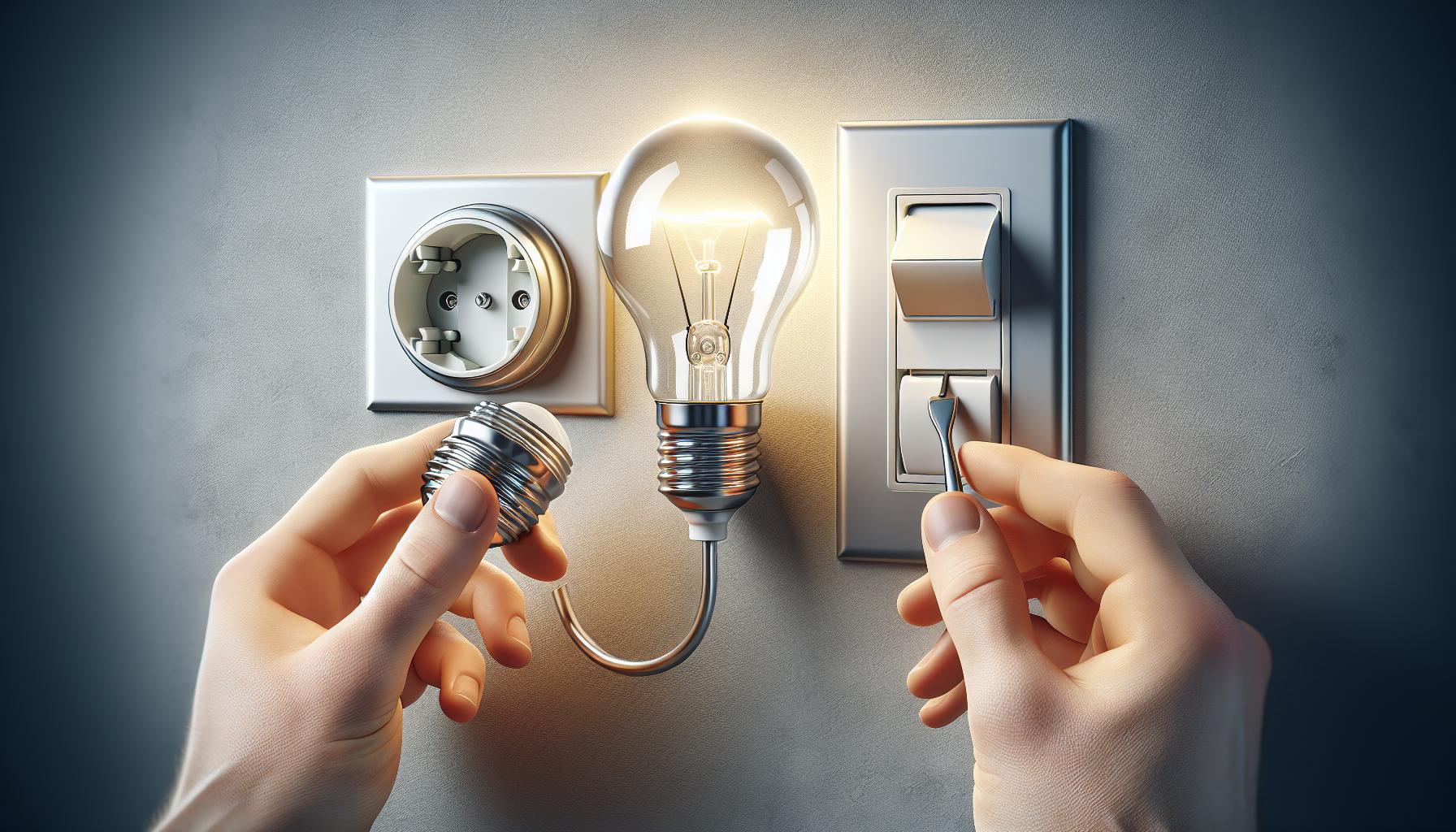Ever wondered how long your trusty light bulb can keep shining before it bids farewell? It’s a question that’s probably flickered through your mind as you flick on a switch. Light bulbs are a staple in every home, but their lifespans can be as varied as the rooms they illuminate.

From the cozy glow of a bedside lamp to the bright beam of a kitchen fixture, light bulbs play a crucial role in your daily life. But just how long can you expect them to last? Let’s shed some light on the lifespan of these everyday essentials and what affects their staying power.
Whether you’re a night owl or just looking for some longevity in your lighting, understanding the endurance of light bulbs can save you time and energy—literally. Ready to get enlightened about the life of your lights? Let’s dive in.
Factors That Affect the Lifespan of Light Bulbs
When you’re deep into your DIY lighting projects, it’s vital to consider what could shorten or extend the life of your bulbs. Here’s what to watch out for:
Quality of the Bulb
Like most things, with light bulbs, you often get what you pay for. Higher-quality bulbs from reputable manufacturers tend to have a longer lifespan. They’re crafted with better materials and undergo more rigorous testing, ensuring they can withstand the rigors of constant use. On the flip side, bargain bulbs might save you money upfront but could fizzle out faster.
Type of Bulb
The type of light bulb you choose plays a significant role in its endurance. Here’s a quick rundown:
- Incandescent bulbs – typically last between 750 to 2,000 hours
- Compact Fluorescent Lights (CFLs) – have a lifespan of roughly 8,000 to 15,000 hours
- Light Emitting Diodes (LEDs) – come out on top with an impressive 15,000 to 50,000 hours
Keep these numbers in mind when selecting bulbs for your projects.
On-Off Frequency
The more often you flick a light on and off, the quicker you can expect it to say goodbye. Each time you power a bulb, it takes a little hit to its life expectancy. You might not notice it day to day, but your on-off habit adds up over time.
Voltage Variations
Fluctuating or incorrect voltage can wreak havoc on your bulbs. Consistent over-voltage conditions can significantly reduce the lifespan of a bulb, while under-voltage can lessen light output. Ensure your home’s voltage matches the requirements of your bulbs for optimal performance.
Operating Temperature
Bulbs are sensitive to their environment. High temperatures can cause overheating, while cold ones can lead to reduced efficacy. For example, hiding a bulb in an unvented fixture might shave off some of its lifespan due to heat buildup.
| Bulb Type | Hours of Use Per Day | Estimated Lifespan (years) |
|---|---|---|
| Incandescent | 4 | 1-1.5 |
Different Types of Light Bulbs and Their Longevity

When you’re immersed in your latest DIY lighting project, picking the right type of bulb is crucial—not just for ambiance, but for longevity too. You wouldn’t want your newly installed lights to flicker out too soon, right? So let’s shine a light on how long different bulbs can stay illuminated.
Incandescent bulbs, your traditional option, have a warm glow that many find cozy and inviting. However, they are the least energy-efficient and generally have the shortest lifespan. On average, incandescent bulbs last about 750 to 2,000 hours. Frequent on-off cycles can shorten this time significantly, so they’re better for spaces where the light stays on for longer periods.
Next, compact fluorescent lamps (CFLs). These bulbs offer a sturdier lifespan and are more energy-efficient. They can last up to 8,000 to 10,000 hours, but their performance takes a hit if you switch them on and off too often. They’re ideal for areas in your home that require long hours of lighting without interruption.
Then we have the champion of endurance: light-emitting diodes (LEDs). LEDs are the choice for the energy-conscious and those who dislike changing bulbs often. Although the upfront cost is higher, they pay off with incredibly long service lives, reaching up to 25,000 to 50,000 hours. Plus, they withstand frequent switching very well, making them suitable for any space in your home.
« Does GE Make Light Bulbs? Unveiling the Future of Smart Lighting
Should Light Bulbs Be Hot? Debunking Myths About LED Heat & Longevity »
Here’s a quick rundown of the average lifespans:
| Bulb Type | Average Lifespan (hours) |
|---|---|
| Incandescent | 750 – 2,000 |
| CFLs | 8,000 – 10,000 |
| LEDs | 25,000 – 50,000 |
Remember, life expectancy varies based on numerous factors, such as usage patterns and brand quality. Be sure to check the manufacturer’s ratings as they can provide more insight into the expected longevity of their products.
How to Make Your Light Bulbs Last Longer

Light bulbs, much like the favorites in your toolshed, need a bit of TLC to extend their shine. You’ve learned about their varying lifespans, but let’s focus on squeezing out every hour of glow from your bulbs.
Choose the Right Bulb for the Right Socket
It all starts with a match – and no, we’re not reigniting your incandescent flames. Pairing the correct wattage and bulb type with your fixtures ensures you’re not overpowering or underutilizing your bulbs. Overpowering shortens the bulb’s life, while underutilizing can lead to poor lighting and inefficiency.
Keep ‘Em Clean
A dust bunny’s paradise is your bulb’s nemesis. Regularly dusting your bulbs and fixtures will prevent overheating, which can occur from an accumulation of grime. Plus, a clean bulb is a brighter bulb – so you’ll get better light without cranking up the juice.
Dimmer Switches Are Your Friend
If you’re partial to mood lighting or simply want to dial down the intensity, dimmer switches are a fantastic way to extend your bulb’s life. By operating your bulbs at lower power, you reduce the stress on the filament, especially in incandescent bulbs, which translates to a longer lifespan.
Avoid Frequent On and Off Cycling
Remember the performance quirks of CFLs? This principle applies across the board. Try to minimize the number of times you flip the switch on and off. Constant cycling puts stress on the bulb’s components, particularly in CFLs and incandescents. With LEDs, you’ve got more flexibility, but steady usage patterns prevail as a rule of thumb for all bulb types.
Invest in Quality Brands
Not all bulbs are created equal. Shelling out a few more dimes for reputable brands can pay off. Quality bulbs often boast better craftsmanship, which can mean resilience against temperature changes, vibrations, and electrical surges – all of which contribute to a longer bulb life.
Armed with these luminary tips, you’re ready to illuminate your space efficiently. Keep them in your lighting playbook, and watch your bulbs outlive expectations, effortlessly echoing the warmth of your cozy DIY nooks.
Signs that Your Light Bulb Needs to be Replaced

When enjoying the glow of your newly optimized light setup, knowing when it’s time for a bulb to head into retirement is vital for maintaining that perfect ambiance. You’ve learned how to extend their life, but recognizing the warning signals that a bulb is on its last filament can save you from sudden darkness and possible inconvenience. Here’s what to look out for:
Flickering or Dimming: This is often the first sign of an old bulb. If you’re certain the electrical supply is stable and your connections are secure, yet your bulb still flickers or has dimmed significantly, it’s likely whispering its goodbyes.
Color Shift: Notice a shift in the color of the light? When bulbs age, they can emit a duller, often more yellow or brownish light. If your once bright white bulb now casts a somber tone, it’s hinting at the end.
Buzzing Sounds: You’re not in a bee sanctuary; that buzzing is probably coming from a bulb that’s struggling to maintain its light output. A stable, silent operation is the hallmark of a healthy bulb. A persistent buzz indicates it’s time to shop for replacements.
Shortened Lifespan: If you’re replacing bulbs more frequently, it’s a sign that the bulb quality may have declined, or it might not be the right fit for its fixture. Keep track of how long your bulbs last to gauge their lifespan accurately.
Bulb won’t light: The most obvious sign is when the bulb won’t illuminate at all. Before you toss it, do a quick check to ensure it’s not merely an issue with the lamp or socket.
Remember, choosing the right bulb from the start and following proper care are key to avoiding these issues. Don’t let dimmed or flickering lights disrupt the serene environment you’ve crafted. With each bulb you replace, consider the previously mentioned tips to make the next one last even longer. Keep your lights shining bright and your rooms full of life.
Conclusion
You’ve got the scoop on keeping your light bulbs glowing longer and the warning signs that it’s time for a change. Remember, the right bulb and a little TLC go a long way in brightening up your space. So next time you flick that switch, rest easy knowing you’re well-informed to make those bulbs last. Happy lighting!
Frequently Asked Questions
How can I choose the right bulb for my socket?
Choose a bulb that matches the socket’s voltage, wattage, and base type specifications. Check the fixture for guidance on suitable bulb types and opt for those that are compatible with your fitting.
What are the benefits of keeping my light bulbs clean?
Dust and dirt can reduce a bulb’s brightness and cause it to overheat, shortening its lifespan. Clean bulbs ensure maximum light output and efficiency, as well as extended longevity.
Can using a dimmer switch extend the life of my light bulbs?
Yes, using dimmer switches can reduce the power flowing to the bulb, thereby generating less heat and extending the bulb’s useful life.
Why should I avoid frequently turning my lights on and off?
Frequent on and off cycling can shorten a light bulb’s lifespan because the surge of electricity when turned on causes more wear on the bulb components than maintaining a steady current.
Are quality brand light bulbs worth the investment?
Investing in quality brand light bulbs often means better craftsmanship and materials, which can lead to improved durability and a longer life for your light bulbs.
What are the signs that a light bulb needs to be replaced?
Signs that a light bulb needs replacing include flickering, dimming, a noticeable color shift, buzzing sounds, a significantly shortened lifespan, and failure to light up at all.




